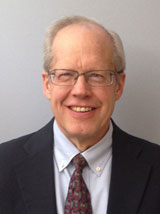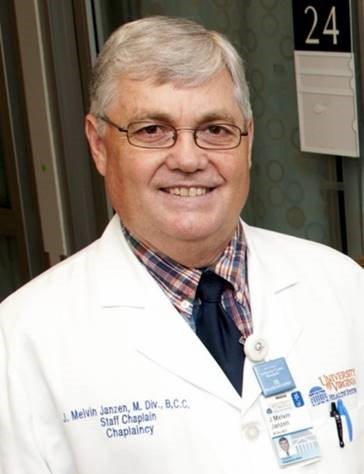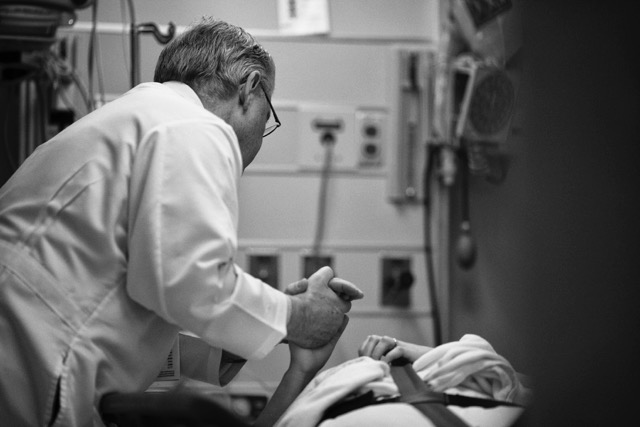By Kate Lichti
(Mennonite Church USA) — As Mennonite Church USA lifts up “Love is a Verb” stories from around the church, Kenton Derstine, director and supervisor of Clinical Pastoral Education (CPE) and associate professor of Supervised  Ministry at Eastern Mennonite Seminary in Harrisonburg, Virginia, reminds us that transformational ministry is happening outside of the church walls, as well. Specifically, Mennonite chaplains are bringing Anabaptist faith to bear on their service in a variety of institutional settings.
Ministry at Eastern Mennonite Seminary in Harrisonburg, Virginia, reminds us that transformational ministry is happening outside of the church walls, as well. Specifically, Mennonite chaplains are bringing Anabaptist faith to bear on their service in a variety of institutional settings.
Since the 1930’s, Clinical Pastoral Education has been the foundational training program for spiritual care providers working in hospitals, prisons, hospices, nursing homes and other healthcare institutions. Many Mennonite seminarians and ministers take Clinical Pastoral Education to enrich their pastoral care experience, and some find a particular call to minister as professional chaplains.
Kenton finds that the “love is a verb” theme resonates for chaplains because it emphasizes that love is primarily a set of behaviors, rather than just a feeling.

Kenton Derstine (Photo provided)
“Love is not easy, and it has to be learned,” Kenton says. “An effort in CPE is to learn how to embody love in really practical ways. Skillful listening is one fundamental way of loving.”
Often working in settings where ministry is not primarily about preaching or teaching doctrinal beliefs but about meeting people from all walks of life, chaplains are particularly challenged to learn a loving way of being. Kenton has found that an Anabaptist perspective can enrich this role.
“Anabaptist spirituality has to do with how you treat other people,” says Kenton. “It’s not just an inward practice.”
Chaplaincy in a multi-faith or secular institution requires being fully respectful of others’ values and beliefs.
“A key belief for professional chaplains is that people should have the freedom to identify their own convictions and that it is not the chaplain’s role to enforce his or her own values,” Kenton says.
He has found that CPE allows participants to explore the challenging nuances of non-violence in interpersonal relationships.
“Non-coercion is a fundamental expression of love,” Kenton continues. “Anabaptists are particularly equipped to minister in this way because they are pioneers in the idea that faith should not be coerced. We haven’t always learned to be pacifists in our more subtle interactions; however, we do have a theology for it.”
For those ministers who pursue professional chaplaincy, Mennonite Chaplains’ Association (MCA) is a network of support. One of MCA’s goals is to create regional meetings for Mennonite chaplains and to assess how chaplains are supported in each MCUSA conference. MCA’s next gathering will be a joint meeting with Mennonite Healthcare Fellowship (successor to Mennonite Doctors and Mennonite Nurses organizations) June 23-25, 2017, at Laurelville Retreat Center near Mount Pleasant, Pennsylvania.
Current MCA president Melvin Janzen says that the organization is open to full-time, part-time and volunteer chaplains. According to Melvin, a recent survey of the approximately 160 chaplains connected to MCUSA (about 50 percent responded) showed that the most common ministry settings are hospice, long-term care facilities, and hospitals, with some chaplains serving in corrections, mental health and academic settings.

Melvin Janzen (Photo provided)
Building a community of chaplains has become more important as professional chaplaincy has become a more common ministerial track, Melvin says.
“In the past, it was expected that Mennonite pastors would begin as a pastor at a church before pursuing chaplaincy,” Melvin says. “Now, there is more of a trend toward people going directly into professional chaplaincy.”
Melvin himself followed the former trajectory, beginning as a pastor in Sioux Falls, South Dakota. After taking a unit of CPE in seminary, he worked quarter-time at Sioux Valley Hospital, then half-time at the University of Wisconsin Hospital before finally becoming a full-time, board-certified chaplain at the University of Virginia Hospital in Charlottesville, where he worked for 14 years before retiring in 2014.
Through this process, Melvin discerned his own ministerial gifts and the call to chaplaincy.
“I wasn’t that strong at preaching, though I liked the discipline of reading the text. I was stronger at worship planning,” Melvin says. “Through working as a hospital chaplain, I learned that I was gifted at meeting strangers, especially strangers in distress. I could walk with them through that moment of distress.”
Melvin remembers being the on-call chaplain with the trauma response team in the Emergency Department.
“Sometimes love is waiting with someone in the midst of an upside-down world,” Melvin says. “When a trauma comes in, for the first hour or so the medical team is focused on assessing the injury, and there is very little information to give to the family. It can be excruciatingly painful to wait in that unknowing. As a chaplain, I was a liaison and advocate between the medical team and the family.”
Just as important, Melvin says, was the role of listening as the family told the story of the traumatic event.
“The family was starting to create a narrative, and my role was to be a listening presence and a non-anxious presence in a very anxious time,” he says.
Melvin also found his gift for worship planning taking a new shape in the hospital setting.

Chaplain Melvin Janzen at the Emergency Department of the University of Virginia Hospital. (Photo by Christopher Tyree / www.christyree.com)
“Ritual doesn’t always have to have explicitly religious content,” he says. “The ritual is the structure, and people take meaning from it in their own ways.”
He found that simple, flexible rituals could help patients, families and hospital staff mark sacred time. He particularly remembers creating rituals of blessing with families who experienced the stillbirth of a child. The actions of naming, blessing with water and singing were ways that family members came together to support one another and to grieve.
Kenton hopes that churches will continue to encourage ministers with these particular gifts, as he believes that chaplains can be transformational leaders.
“In many ways, Jesus’ style of ministry often reflects that of a chaplain. He walked around and often engaged people rather briefly,” says Kenton, who finds that the same can be said of a chaplain in a modern hospital.

